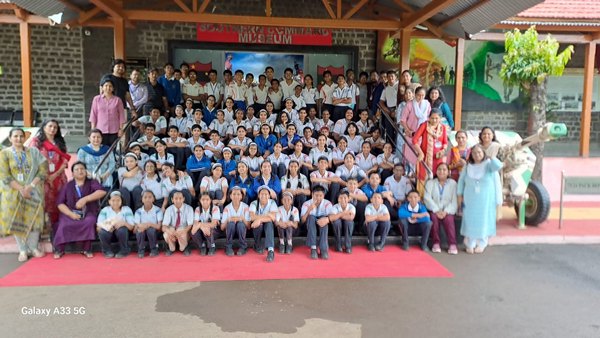
The Heritage Club
NAME OF THE ACTIVITY: A visit to the National War Memorial and Museum, and the Shinde Chhatri
Another fascinating historical place the Heritage Club visited was the Shinde Chattri and the National War Memorial and Museum on Saturday13th July 2024. We started at 8.30 am along with our guides Mr Arbaaz and Mr Aditya. Our visit to the National War Museum was
nothing short of magical. The mood of the students was upbeat and full of patriotic fervour. The students were amazed to learn that the War Memorial was constructed by raising money through contributions from people and corporate houses. The Memorial is dedicated to all the
brave sons of India who made the supreme sacrifice while fighting with the enemies of the Nation. The Memorial was dedicated to the Nation on 15th August 1998.
The National War Memorial complex also has the Southern Command and Maratha Museums within its premises. The complex showcases several artefacts, belonging to the Indian Army, Indian Navy and Indian Air Force, also called the Tri-Services. The students were filled with astonishment to see the MIG-23 BN fighter aircraft, the Vijayanta Main Battle Tank, a replica of the Indian Naval Ship Trishul, Artillery guns, Armoured tanks, Air Defence munition, automatic and semiautomatic weapons, vehicles, equipment, and uniforms worn by the Armed Forces Personnel. The museum displays numerous paintings, models, statues and plaques highlighting famous battles, military campaigns, war heroes, gallantry awards and other achievements of the Armed Forces from the pre-independence and post-
independence eras. One of the prized possessions of the Museum is a Portuguese Flag captured during the battle for the Liberation of Goa and like all captured flags, it is displayed upside down. Mr Arun Kumar, the person in charge of the Museum, also elucidated about
the ammunition in brief to our students. The slogan – ‘One Flag, One Land, One Heart, One Nation’ made everyone stand up with the affection that the Warrior Ethos is a set of principles by which every Soldier lives. As the tour culminated, we came across an ex-army
officer who was a gallantry award winner. He spoke to the children briefly and was very happy to get clicked with the young generation of India. In unison he made them chant ‘Jai Jawan.. Jai Kisan’.
The students walked with confidence and pride after having witnessed the rich traditions of the Indian Armed Forces. This activity, without a shadow of a doubt, will motivate many of our students to serve our Nation, not only by joining the Armed Forces but also by choosing
various other professions to serve the Motherland.
Thereafter, we moved on to the rectangular complex surrounded by trees called the Shinde Chhatri. This richly decorated memorial to a revered warrior of the Maratha Empire showcased an interesting blend of Rajasthani and British-style architecture. The Shinde
Chhatri is a temple dedicated to Mahadaji Shinde, who was the well-known commander-in- chief of the Maratha Army during the 1700s.
In this elegant landmark, we saw a stylish façade, a portrait gallery and the tomb of its eponymous war hero. Mahadaji Shinde himself began the construction of Shinde Chhatri in 1793 when its sole building was a shrine to Lord Shiva. Shinde passed away a year later and
it wasn’t until 1965 that the politician Madhavrao Scindia commissioned the temple that stands today in the cool by-lanes of Pune’s Wanowrie area.
The temple is square in shape and displays an Anglo-Rajasthan architectural style. The exterior walls are with two levels of windows with colourful panes of glass, capitals, pilasters and floral carvings. Sculptures of gods and saints sit around a balustrade. To the rear is the
original Shiva Temple built by Mahadaji Shinde.
Above the arches on the lower floor are photos of members of the Shinde (also known as Scindia) Dynasty. They were a noble clan from Maharashtra that ruled the historic kingdom of Gwalior until India’s Independence in 1947.
At the back of the temple is a statue of Mahadaji Shinde with an orange-hued turban. It stands where Shinde’s cremation and last rites took place.
The temple complex had a beautiful sense of peace and tranquillity. The children meditated there for a few minutes and were then briefly explained the history of the temple by the guide who had accompanied us. The clean and breezy environs of this heritage structure with its
aesthetic beauty made our day a productive one. The students were seen taking notes and enjoying themselves.
Report Compiled by: Ms. Maria Waghmare
Report Edited by: Ms. Shaheen Chaiwala




